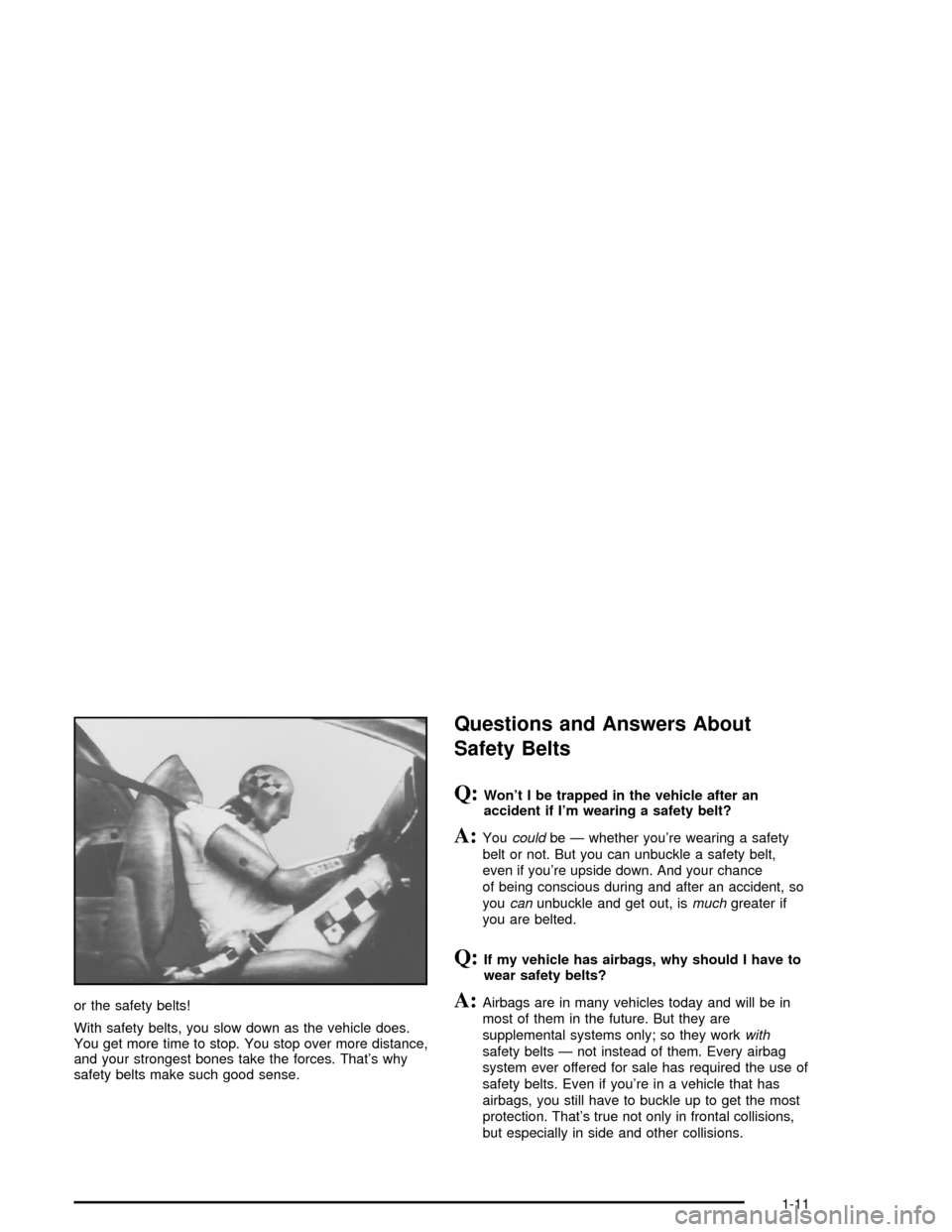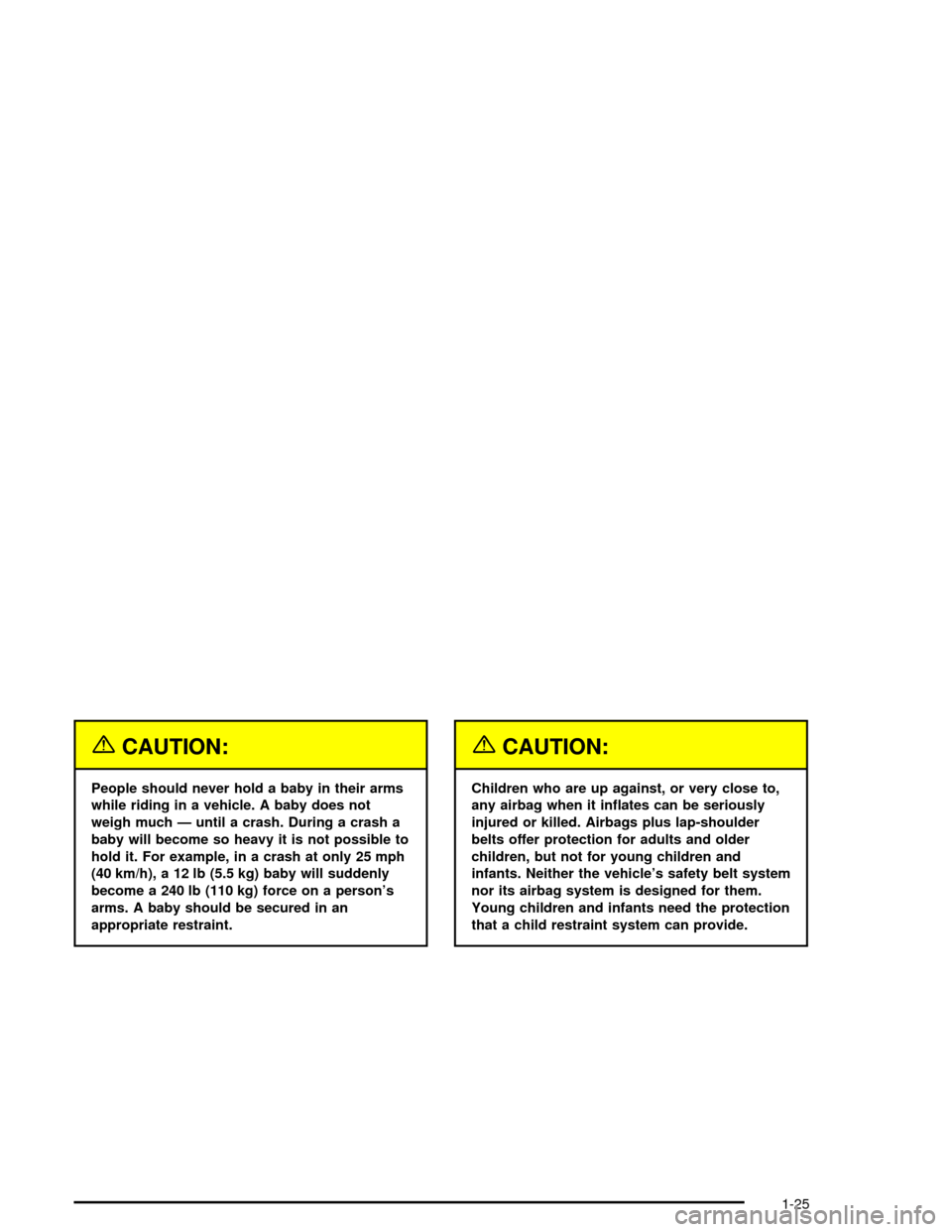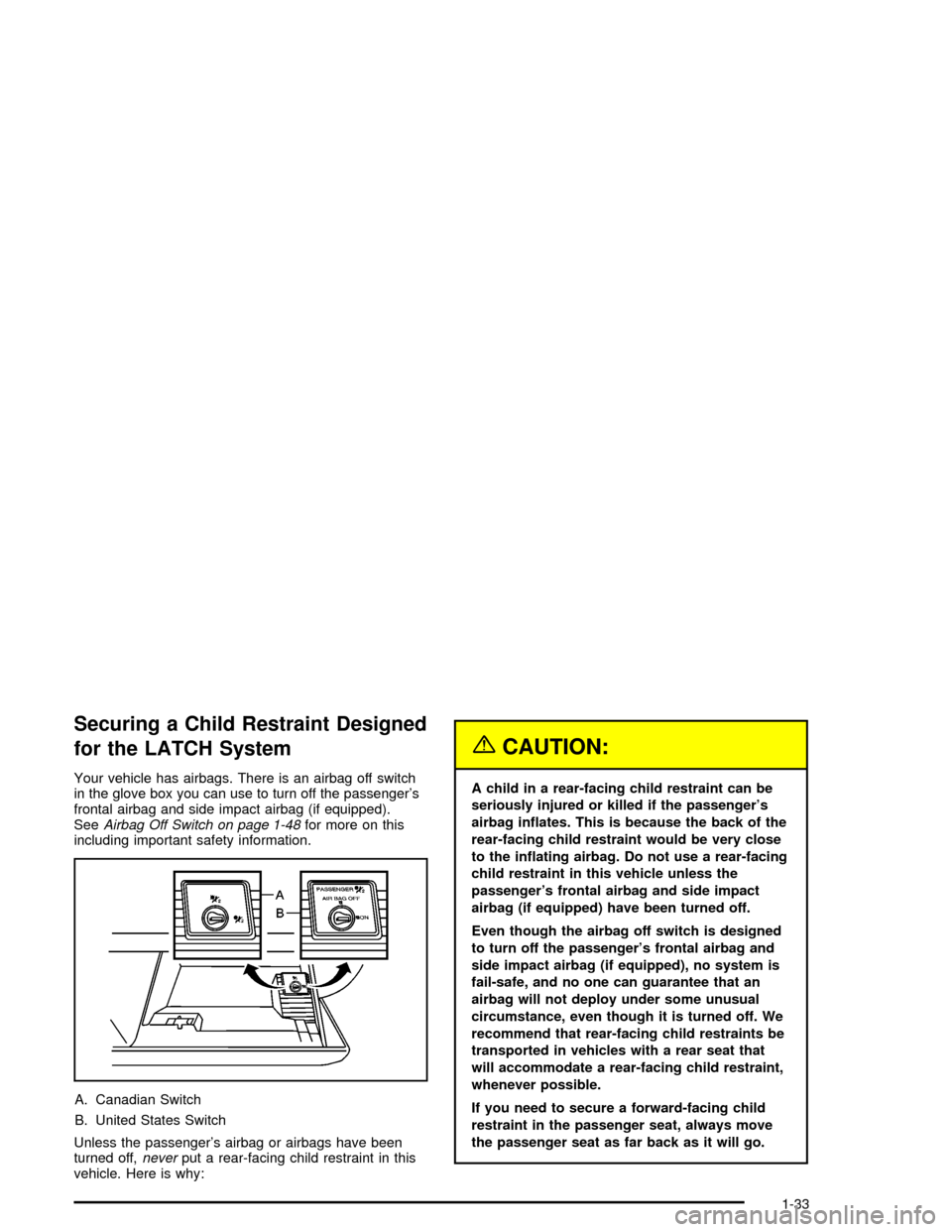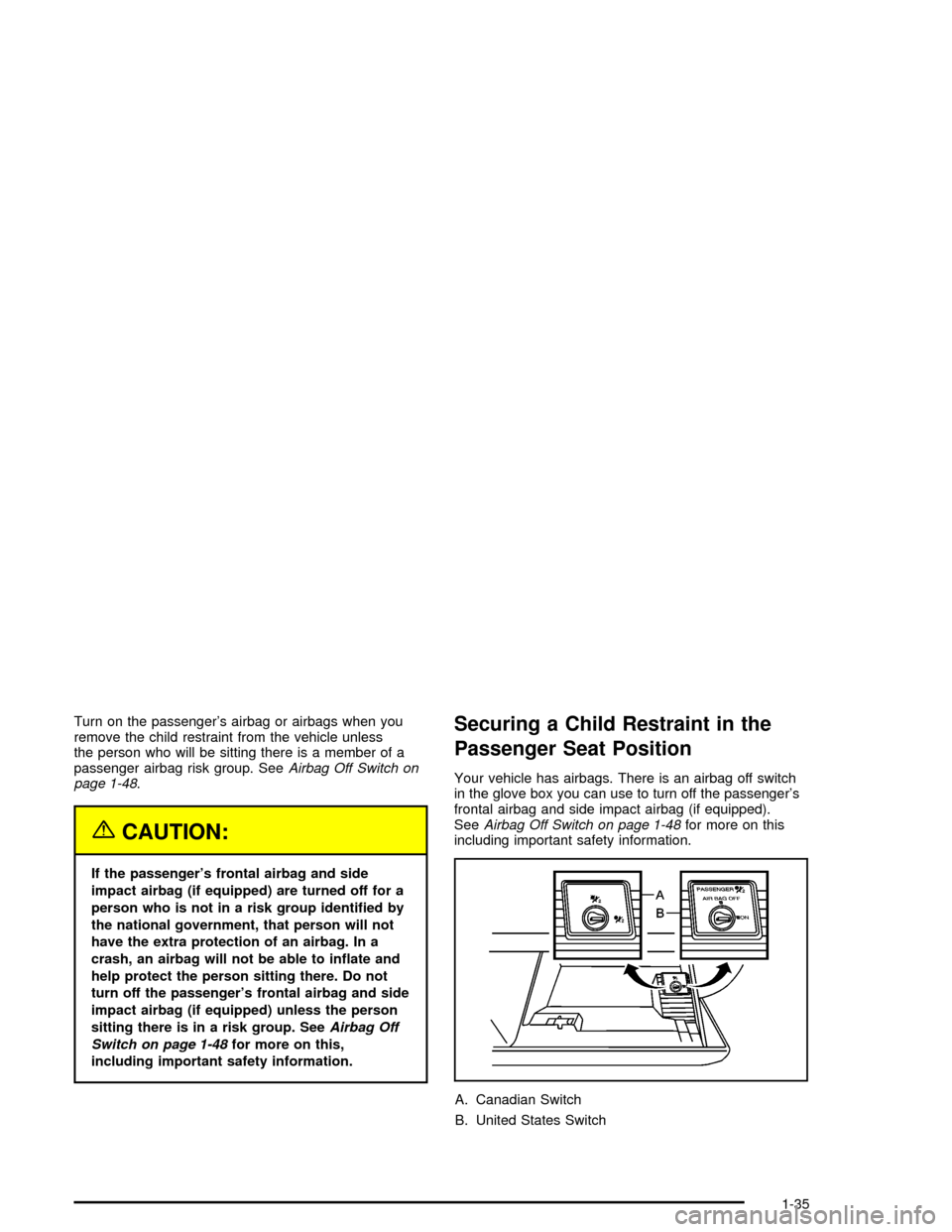2005 CHEVROLET CORVETTE airbag off
[x] Cancel search: airbag offPage 7 of 400

Front Seats......................................................1-2
Manual Seats................................................1-2
Six-Way Power Seats.....................................1-2
Power Lumbar and Side Bolsters......................1-3
Heated Seats.................................................1-4
Reclining Seatbacks........................................1-4
Seatback Latches...........................................1-6
Safety Belts.....................................................1-7
Safety Belts: They Are for Everyone.................1-7
Questions and Answers About Safety Belts......1-11
How to Wear Safety Belts Properly.................1-12
Driver Position..............................................1-13
Safety Belt Use During Pregnancy..................1-19
Passenger Position.......................................1-20
Safety Belt Pretensioners...............................1-20
Safety Belt Extender.....................................1-20
Child Restraints.............................................1-21
Older Children..............................................1-21
Infants and Young Children............................1-24
Child Restraint Systems.................................1-27
Top Strap....................................................1-31Lower Anchorages and Top Tethers for
Children (LATCH System)...........................1-31
Securing a Child Restraint Designed for the
LATCH System.........................................1-33
Securing a Child Restraint in the Passenger
Seat Position............................................1-35
Airbag System...............................................1-40
Where Are the Airbags?................................1-42
When Should an Airbag In�ate?.....................1-45
What Makes an Airbag In�ate?.......................1-46
How Does an Airbag Restrain?.......................1-46
What Will You See After an Airbag In�ates?.....1-46
Airbag Off Switch..........................................1-48
Servicing Your Airbag-Equipped Vehicle...........1-51
Restraint System Check..................................1-51
Checking the Restraint Systems......................1-51
Replacing Restraint System Parts After
a Crash...................................................1-52
Section 1 Seats and Restraint Systems
1-1
Page 17 of 400

or the safety belts!
With safety belts, you slow down as the vehicle does.
You get more time to stop. You stop over more distance,
and your strongest bones take the forces. That’s why
safety belts make such good sense.
Questions and Answers About
Safety Belts
Q:Won’t I be trapped in the vehicle after an
accident if I’m wearing a safety belt?
A:Youcouldbe — whether you’re wearing a safety
belt or not. But you can unbuckle a safety belt,
even if you’re upside down. And your chance
of being conscious during and after an accident, so
youcanunbuckle and get out, ismuchgreater if
you are belted.
Q:If my vehicle has airbags, why should I have to
wear safety belts?
A:Airbags are in many vehicles today and will be in
most of them in the future. But they are
supplemental systems only; so they workwith
safety belts — not instead of them. Every airbag
system ever offered for sale has required the use of
safety belts. Even if you’re in a vehicle that has
airbags, you still have to buckle up to get the most
protection. That’s true not only in frontal collisions,
but especially in side and other collisions.
1-11
Page 31 of 400

{CAUTION:
People should never hold a baby in their arms
while riding in a vehicle. A baby does not
weigh much — until a crash. During a crash a
baby will become so heavy it is not possible to
hold it. For example, in a crash at only 25 mph
(40 km/h), a 12 lb (5.5 kg) baby will suddenly
become a 240 lb (110 kg) force on a person’s
arms. A baby should be secured in an
appropriate restraint.
{CAUTION:
Children who are up against, or very close to,
any airbag when it in�ates can be seriously
injured or killed. Airbags plus lap-shoulder
belts offer protection for adults and older
children, but not for young children and
infants. Neither the vehicle’s safety belt system
nor its airbag system is designed for them.
Young children and infants need the protection
that a child restraint system can provide.
1-25
Page 36 of 400

When choosing a child restraint, be sure the child
restraint is designed to be used in a vehicle. If it is, it
will have a label saying that it meets federal motor
vehicle safety standards.
Then follow the instructions for the restraint. You may
�nd these instructions on the restraint itself or in a
booklet, or both. These restraints use the belt system in
your vehicle, but the child also has to be secured
within the restraint to help reduce the chance of personal
injury. When securing an add-on child restraint, refer
to the instructions that come with the restraint which may
be on the restraint itself or in a booklet, or both, and
to this manual. The child restraint instructions are
important, so if they are not available, obtain a
replacement copy from the manufacturer.
The child restraint must be secured properly in the
passenger seat. If you want to secure a rear-facing child
restraint in the passenger’s seat, turn off the passenger’s
airbag. SeeAirbag Off Switch on page 1-48and
Securing a Child Restraint in the Passenger Seat
Position on page 1-35for more on this, including
important safety information.
{CAUTION:
A child in a rear-facing child restraint can be
seriously injured or killed if the passenger’s
airbag in�ates. This is because the back of the
rear-facing child restraint would be very close
to the in�ating airbag. Be sure to turn off the
airbag before using a rear-facing child restraint
in the passenger seat position.
Keep in mind that an unsecured child restraint can
move around in a collision or sudden stop and injure
people in the vehicle. Be sure to properly secure
any child restraint in your vehicle – even when no child
is in it.
1-30
Page 39 of 400

Securing a Child Restraint Designed
for the LATCH System
Your vehicle has airbags. There is an airbag off switch
in the glove box you can use to turn off the passenger’s
frontal airbag and side impact airbag (if equipped).
SeeAirbag Off Switch on page 1-48for more on this
including important safety information.
A. Canadian Switch
B. United States Switch
Unless the passenger’s airbag or airbags have been
turned off,neverput a rear-facing child restraint in this
vehicle. Here is why:
{CAUTION:
A child in a rear-facing child restraint can be
seriously injured or killed if the passenger’s
airbag in�ates. This is because the back of the
rear-facing child restraint would be very close
to the in�ating airbag. Do not use a rear-facing
child restraint in this vehicle unless the
passenger’s frontal airbag and side impact
airbag (if equipped) have been turned off.
Even though the airbag off switch is designed
to turn off the passenger’s frontal airbag and
side impact airbag (if equipped), no system is
fail-safe, and no one can guarantee that an
airbag will not deploy under some unusual
circumstance, even though it is turned off. We
recommend that rear-facing child restraints be
transported in vehicles with a rear seat that
will accommodate a rear-facing child restraint,
whenever possible.
If you need to secure a forward-facing child
restraint in the passenger seat, always move
the passenger seat as far back as it will go.
1-33
Page 40 of 400

{CAUTION:
If the airbag readiness light ever comes on
when you have turned off the passenger’s
frontal airbag and side impact airbag
(if equipped), it means that something may
be wrong with the airbag system. The
passenger’s frontal airbag and side impact
airbag (if equipped) could in�ate even though
the switch is off. If this ever happens, do not
let anyone whom the national government has
identi�ed as a member of a passenger airbag
risk group sit in the passenger’s position
(for example, do not secure a rear-facing child
restraint in your vehicle) until you have your
vehicle serviced. SeeAirbag Off Switch on
page 1-48.
There are no top strap anchors in your vehicle. Do not
secure a child seat in your vehicle if a national or
local law requires that the top strap be anchored, or ifthe instructions that come with the restraint say that the
top strap must be anchored.
1. Your vehicle has airbags. SeeAirbag Off Switch on
page 1-48. If your child restraint is forward-facing,
always move the seat as far back as it will go before
securing it in this seat. SeeManual Seats on
page 1-2orSix-Way Power Seats on page 1-2.
Never use a rear-facing child restraint in this seat
unless the airbag is off.
2. Find the LATCH anchorages in the passenger seat.
SeeLower Anchorages and Top Tethers for
Children (LATCH System) on page 1-31.
3. Put the child restraint on the seat.
4. Attach and tighten the LATCH attachments on the
child restraint to the LATCH anchorages in the
vehicle. The child restraint instructions will show you
how. SeeTop Strap on page 1-31if your child
restraint has one.
5. Push and pull the child restraint in different
directions to be sure it is secure.
To remove the child restraint, simply unhook the top
tether from the top tether anchorage and then
disconnect the LATCH anchorages.
1-34
Page 41 of 400

Turn on the passenger’s airbag or airbags when you
remove the child restraint from the vehicle unless
the person who will be sitting there is a member of a
passenger airbag risk group. SeeAirbag Off Switch on
page 1-48.
{CAUTION:
If the passenger’s frontal airbag and side
impact airbag (if equipped) are turned off for a
person who is not in a risk group identi�ed by
the national government, that person will not
have the extra protection of an airbag. In a
crash, an airbag will not be able to in�ate and
help protect the person sitting there. Do not
turn off the passenger’s frontal airbag and side
impact airbag (if equipped) unless the person
sitting there is in a risk group. SeeAirbag Off
Switch on page 1-48for more on this,
including important safety information.
Securing a Child Restraint in the
Passenger Seat Position
Your vehicle has airbags. There is an airbag off switch
in the glove box you can use to turn off the passenger’s
frontal airbag and side impact airbag (if equipped).
SeeAirbag Off Switch on page 1-48for more on this
including important safety information.
A. Canadian Switch
B. United States Switch
1-35
Page 42 of 400

Unless the passenger’s airbag or airbags have been
turned off,neverput a rear-facing child restraint in this
vehicle. Here is why:
{CAUTION:
A child in a rear-facing child restraint can be
seriously injured or killed if the passenger’s
airbag in�ates. This is because the back of the
rear-facing child restraint would be very close
to the in�ating airbag. Do not use a rear-facing
child restraint in this vehicle unless the
passenger’s frontal airbag and side impact
airbag (if equipped) have been turned off.
CAUTION: (Continued)
CAUTION: (Continued)
Even though the airbag off switch is designed
to turn off the passenger’s frontal airbag and
side impact airbag (if equipped), no system is
fail-safe, and no one can guarantee that an
airbag will not deploy under some unusual
circumstance, even though it is turned off. We
recommend that rear-facing child restraints be
transported in vehicles with a rear seat that
will accommodate a rear-facing child restraint,
whenever possible.
If you need to secure a forward-facing child
restraint in the passenger seat, always move
the passenger seat as far back as it will go.
1-36